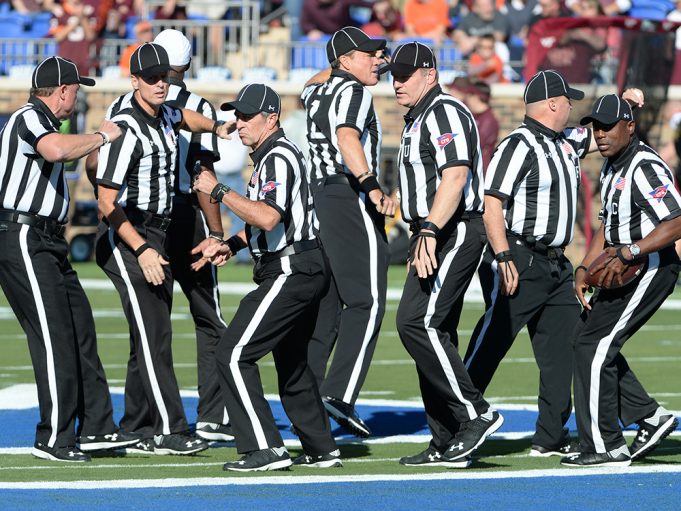The Big 12 Conference staged its first football championship game in seven seasons on Dec. 2, 2017, matching Oklahoma and TCU. Referee Mike Defee headed the officiating crew, which included umpire Robert Richeson, linesman Al Green, line judge Derek Anderson, field judge Joe Blubaugh, side judge Lo vanPham, back judge Terry Jones and center judge Marvel July.
The crew had worked together all season before being assigned to the title game by Walt Anderson, who recently retired as the Big 12’s officiating coordinator.
Anderson, who had been the Big 12’s coordinator since 2006 before stepping down to focus on his NFL responsibilities, noted the advantages of assigning postseason games by crew.
“As long as officials had an exceptional year,” he said, “and are going to be warranting assignment of some type, in my opinion, if the assignments can include as many members of the regular crew as it can, I feel that enhances the ability of the crew to work together more effectively.”
Following the conference championship game, the Big 12 was responsible for assigning five bowl games, including the Fiesta Bowl between Penn State and Washington. In making those assignments, Anderson tried to keep crew members together when possible and indeed, six members of the crew that worked the conference championship game were assigned to the Fiesta Bowl.
But there were other criteria involved. Anderson told Referee that when it comes to a New Year’s Six bowl, a national semifinal or the national championship game, he prefers to assign the top-ranked officials available, regardless of their crew assignment during the regular season. For other bowls, he tries to keep crew members together when possible.
“If officials on an individual crew are among the group that is going to be assigned a bowl game, I will try to assign them together,” Anderson said. “Simply because I do believe that if you can work officials who have worked together during the year, I believe you have a better chance of efficiency and effectiveness as opposed to putting people together that have not worked together in quite some time.”
The NFL has varied its methodology for assigning postseason crews. In some seasons, it has assigned by crews. In others, it has made assignments based on ratings. On occasion, it has utilized both methods, utilizing the crew system in the early rounds and the individual system in subsequent rounds.
At the high school level, policies may vary from sport to sport. New Jersey and Wisconsin make their postseason football assignments by crews.
Wade Lebecki is a deputy director with the Wisconsin Interscholastic Athletic Association. He assigns five-person crews to his football playoff games, crews that have worked together all season.
“They’re familiar with their mechanics and they’re familiar with their signals,” he says. “That’s probably the biggest thing. It’s also, I believe, a reward for the entire crew, a reward for their years of experience, so we’re not pulling them apart.”
The 100 football-playing schools in Utah are spread out across the state’s 84,899 square miles. Approximately 70 percent of them are situated in a region known as the Wasatch Front, which stretches some 150 miles north to south. The area includes Salt Lake City, Provo and Ogden, and is home to some 80 percent of the state’s population.
Jeff Cluff, an assistant director with the Utah High School Activities Association, assigns every varsity game played in the state, including postseason games, on an individual basis.
Cluff, who also assigns boys’ basketball games across the state and works college baseball himself, is starting his fifth season assigning football. He has employed a variety of assigning methodologies, varying from assigning individually, to putting three officials together for three weeks at a time and then adding two more to their crew each week. He has also assigned entire crews as well as having representatives from each of the football associations around the state assist in the process. For 2018 he’ll return to using an individual system for the 10-week regular season plus the postseason.
“Four years in the office and we’ve assigned four different ways,” he says. “Now we’re back to the original way.”
Utah’s football officials board, which includes a representative from each of seven associations from around the state, has the final say on assigning, but it traditionally defers to Cluff.
“I push them one way or another,” he said. “I give them my strong opinion which carries quite a bit of weight.”
The Pennsylvania Interscholastic Athletic Association (PIAA) divides the state into 12 districts. Assignments for the first phase of the postseason in all sports are made at the district level.
Once the state playoffs begins, each district recommends a list of officials for state tournament assignments. Postseason crews consist of seven officials. If a crew is assigned to work a game in the state football playoffs it will likely remain together for subsequent assignments (assuming all members of the crew are available).
Mark Byers, the PIAA’s chief operating officer, said the same protocol is followed in baseball and softball. “Based on availability of each member of the crew, baseball and softball crews move forward on their merits,” he said, “and are assigned by position within the crew.”
At the high school level, assignment methodologies are often dictated by logistics. Simply put, in sports other than football, which schedules during the week, it is often difficult to keep an entire crew together, particularly during a state tournament, which may involve a lot of travel.
Recently, the PIAA expanded its state playoff structure, creating additional classes in a number of sports. That means more contests to assign but not necessarily more playoff-caliber officials available.
Last fall, the PIAA changed its procedure for basketball and soccer and began assigning officials individually rather than as crews. Byers says the change was made because of the increased number of postseason assignments in those sports and because many of the state’s best officials also work at other levels and may not be available for every round of the state tournament.
“(Making individual assignments) provided a greater flexibility to advance officials through the tournament without being reliant on the entire crew being available,” Byers said. “Basketball and soccer officials also rotate throughout the course of the game, unlike football, baseball and softball, which are assigned by position.”
What's Your Call? Leave a Comment:
Note: This article is archival in nature. Rules, interpretations, mechanics, philosophies and other information may or may not be correct for the current year.
This article is the copyright of ©Referee Enterprises, Inc., and may not be republished in whole or in part online, in print or in any capacity without expressed written permission from Referee. The article is made available for educational use by individuals.

















